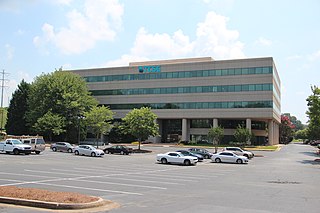An integrated library system (ILS), also known as a library management system (LMS), is an enterprise resource planning system for a library, used to track items owned, orders made, bills paid, and patrons who have borrowed.
Evergreen is an open-source integrated library system (ILS), initially developed by the Georgia Public Library Service for Public Information Network for Electronic Services (PINES), a statewide resource-sharing consortium with over 270 member libraries.
SirsiDynix is a United States company which produces integrated library system (ILS) software and associated services for libraries.
BiblioCommons is a privately held company, based in Toronto, Ontario, Canada, that develops front end interactive catalog and web services for libraries. In February 2020, BiblioCommons was acquired by Volaris Group, an operating segment of Constellation Software.

The Sara Hightower Regional Library System (SHRLS) is a system of 6 public libraries in the Northwest Georgia region serving Chattooga County, Polk County and Floyd County. The headquarters of the library system is located in Rome, Georgia, at the Rome-Floyd County Library.

The Flint River Regional Library System (FRRLS) is a collection of nine public libraries in the Atlanta metropolitan area of Georgia. The library serves the residents of the following six counties: Butts, Fayette, Lamar, Monroe, Pike, and Spalding.
The Azalea Regional Library System (AZRLS) is a collection of ten public libraries located partially in the Atlanta metropolitan area and Central Georgia. It is headquartered in Madison, Georgia and serves the counties of Greene, Hancock, Jasper, Morgan, Putnam, and Walton, of which 32% of the population are members of the library.

The Athens Regional Library System (ARLS) is a consortium of 11 public libraries across five counties, comprising the Athens – Clarke County metropolitan area as well as Franklin County in northeast Georgia, United States.
The Chattooga County Library System (CCLS) was a public library system consisting of two libraries in Chattooga County, Georgia, United States, in the northwest region of the state. On 1 November 2020, the library system merged with the Sara Hightower Regional Library System. The library headquarters and main branch is located in Summerville with a second, smaller branch in Trion.
The Cherokee Regional Library System (CRLS) is a public library system consisting of four libraries in the counties of Walker and Dade, Georgia. The central library, the Lafayette-Walker County Public Library, is located in LaFayette, Georgia.
The Newton County Library System (NCLS) is a consortium of two public libraries in Newton County, Georgia, United States. The system has libraries in Covington.
The Greater Clarks Hill Regional Library System (GCHRL) is a consortium of eight public libraries working together to serve the populations of Columbia, Burke, Lincoln, and Warren counties in east Georgia.

The Troup-Harris Regional Library (THRL) is a public library system serving the counties of Troup, and Harris, Georgia, United States. The central library, LaGrange Memorial, is located in LaGrange, Georgia.

The Live Oak Public Libraries are a consortium of sixteen public libraries in the Savannah metropolitan area and Hinesville – Fort Stewart metropolitan area of Georgia, United States. The library provides services for Chatham County, Effingham County, and Liberty County. The library headquarters are located in the Bull Street Library in Savannah, which is one of two Carnegie libraries in the system.

The Three Rivers Regional Library System (TRRLS) is a public library system that serves the counties of Brantley, Camden, Charlton, Long, McIntosh, and Wayne, Georgia, United States. The administrative office of the system is located in Jesup.

The Catoosa County Library is a single branch public library system serving Catoosa County, Georgia, United States. The library branch is located in Ringgold.

The Chattahoochee Valley Libraries (CVL) are a consortium of public libraries serving the Greater Columbus area of Georgia, United States. The library system consists of seven branches over four counties, Muscogee, Chattahoochee, Marion, and Stewart, Georgia. The headquarters of the library system is the Columbus Public Library located in the county seat, Columbus.

The Lake Blackshear Regional Library System (LBRLS) is a public library system covering the four counties of Sumter, Crisp, Dooly, Schley, Georgia, United States. The Lake Blackshear Headquarters Library is located in Americus. The system is also home to the second oldest Carnegie library in Georgia, located in Cordele.

The Georgia Public Library Service (GPLS) is the state agency for libraries in the U.S. State of Georgia and a unit of the University System of Georgia. The service was initially founded in 1996 after the inception of the Library Services and Technology Act (LSTA), and in July 2000 moved from the Georgia Department of Technical and Adult Education (DTAE) to the Georgia Board of Regents and University System of Georgia. Julie Walker is the current State Librarian.

The Starkville-Oktibbeha County Public Library System is a public library system serving Oktibbeha County, Mississippi. The library consists of three branches with the headquarters library, the Starkville Public Library, located in Starkville, Mississippi.











